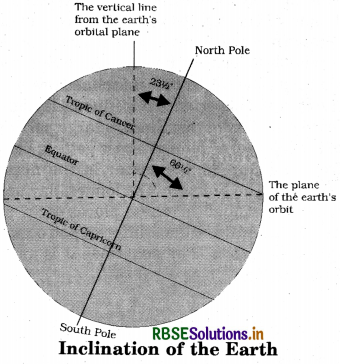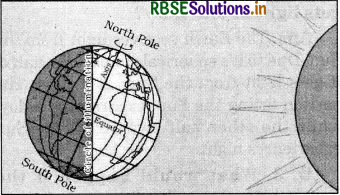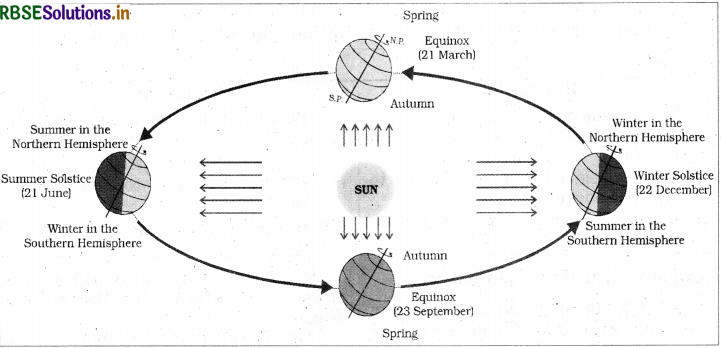RBSE Class 6 Social Science Important Questions Geography Chapter 3 Motions of the Earth
Rajasthan Board RBSE Class 6 Social Science Important Questions Geography Chapter 3 Motions of the Earth Important Questions and Answers.
RBSE Class 6 Social Science Important Questions Geography Chapter 3 Motions of the Earth
Multiple Choice Questions
Question 1.
If 2016 was a leap year, which will be the next leap year?
(a) 2018
(b) 2020
(c) 2019
(d) 2017.
Answer:
(b) 2020

Question 2.
Seasons change due to change in the position of the:
(a) Earth around the Sun
(b) Earth around the Moon
(c) Sun around the Earth
(d) Sun around the Moon.
Answer:
(a) Earth around the Sun
Question 3.
The longest day in Southern Hemisphere is on:
(a) 22 March
(b) 21 June
(c) 22 September
(d) 22 December.
Answer:
(d) 22 December.
Question 4.
At the time of the equinox, rays of the Sun fall direct on the:
(a) Equator
(b) North pole
(c) Tropic of Cancer
(d) Tropic of Capricorn.
Answer:
(a) Equator
Question 5.
Earth rotates from
(a) East to West
(b) West to East
(c) North to South
(d) South to North.
Answer:
(b) West to East
Fill in the blanks
Question 1.
Two motions of the Earth are ................ and ................
Answer:
Rotation and Revolution
Question 2.
A year is divided into ................ seasons.
Answer:
four
Question 3.
The period of rotation is known as the ................
Answer:
earth day
Question 4.
Earth ................ around the Sim in a fixed orbit.
Answer:
revolves,
Question 5.
Every fourth year, the surplus day is added to the month of ................
Answer:
February.
True/False
Question 1.
The axis of the earth is a real line.
Answer:
False.
Question 2.
The earth receives only half of the light from the sun at a time.
Answer:
True
Question 3.
We consider a year as consisting of36514 days.
Answer:
False.
Question 4.
A year with 366 days is called a leap year.
Answer:
True
Question 5.
There are changes in the seasons because of the rotation of the Earth.
Answer:
False.

Match the column
|
Column A |
Column B |
|
1. Rotation |
(a) The plane passing through the Earth |
|
2. Axis |
(b) Length of day and night is equal |
|
3. Orbit |
(c) The path on which the Earth moves around the Sun. |
|
4. Orbital Plane |
(d) 21st June |
Answer:
|
Column A |
Column B |
|
1. Rotation |
(d) 21st June |
|
2. Axis |
(b) Length of day and night is equal |
|
3. Orbit |
(c) The path on which the Earth moves around the Sun. |
|
4. Orbital Plane |
(a) The plane passing through the Earth |
Very Short Answer Type Questions
Question 1.
Name the two movements of the Earth.
Answer:
The two movements of the Earth are Rotation and Revolution.
Question 2.
Define the circle of Illumi¬nation.
Answer:
The circle that divides the day from night, on the globe is known as the Circle of illumination.
Question 3.
In which direction the Earth rotates? What is the time taken by the Earth to complete one rotation on its axis?
Answer:
Earth rotates from west to east and takes about 24 hours to complete one rotation on its axis.
Question 4.
Why the day is shortest in the Northern Hemisphere on z,2nd December?
Answer:
On 22nd December, sunrays are slanting at the Tropic of Cancer which has the Winter Solstice and hence the day is shortest.
Question 5.
What are the two factors responsible for the formation of seasons?
Answer:
The Revolution of the Earth and the tilt of the Earth’s axis result in the formation of seasons.
Question 6.
Why do the areas near the poles receive less heat?
Answer:
It is because the rays of the Sun are slanting on the poles so they receive very less heat.
Question 7.
When do the longest day and the shortest night occur in the Northern Hemisphere?
Answer:
On 21st June, the longest day and shortest night occur in Northern Hemisphere.
Question 8.
Which place is called as the land of the midnight sun?
Answer:
Norway is known as the land of the midnight Sun.
Short Answer Type Questions
Question 1.
With the help of a diagram, explain what is the inclination of the Earth's Axis?
Answer:
The Earth remains titled to one side while it revolves around the Sun. This tilt is

Question 2.
Why only one half of the Earth gets light at one time?
Answer:
The Earth receives light from the Sun. Due to it’s spherical shape, only half of it gets light from the Sun, at a time. The portion facing the Sun, experiences a day, while the other half away from the Sun experiences night.

Question 3.
What would happen if the Earth did not revolve?
Answer:
If the Earth did not revolve, then:
- There would be no change in seasons.
- There would not be a variety of flora and fauna on the Earth.
- The duration of day and night would remain the same.
Question 4.
Distinguish between revo¬lution and rotation of the earth.
|
Revolution |
Rotation |
|
(i) The movement of the earth around the sun in a fixed path or orbit is called revolution. |
(i) Rotation is the movement of the earth on its axis. |
|
(ii) Earth takes 365 days and 6 hours to complete one revolution. |
(ii) It takes 24 hours to complete one rotation. |
|
(iii) Due to revolution, the change of seasons takes place. |
(iii) It causes day and night in all parts of the earth. |
Long Answer Type Questions
Question 1.
Why the daylight time is longer in summer while it is shorter in winter?
Answer:
This is because of the inclination of the Earth on it axis. During Summer, a large part of the Northern Hemisphere remains inclined toward the Sun. So, there are long hours of daylight during summer. In contrast, a larger part of the Southern Hemisphere is away from the sun, experiences longer hours of darkness, and has longer nights. This becomes vice-versa when the Southern Hemisphere is tilted towards the Sun.
Question 2.
How days and nights are caused? Explain with the help of a diagram.
Answer:
The Earth revolves around the Sun and rotates on its own axis. The rotation of the Earth causes day and night. The part of the Earth which faces the Sun, experiences the daytime whereas the part away from the Sun gets no Sunlight and hence night occurs. The rotation of the Earth is from west to east, hence for the observer on Earth, it appears that the Sun is moving from east to west. The axis of Earth’s rotation is tilted at 23^°. Due to this, the poles experience 6 months of day and 6 months of night.

Question 3.
With the help of diagram, explain the revolution of the Earth and the changing seasons.
Answer:
The position of the Earth changes when it revolves around the Sun on its orbit. This revolution and tilt of the Earth’s axis
causes changes in the seasons. On 21st June, the northern hemisphere is tilted towards the Sun. The rays of the Sun fall directly on the Tropic pf Cancer. As a result, these areas receive more heat. The areas near the poles receive less heat as the rays of the Sun are slanting. The North Pole is inclined towards the Sun and experiences continuous daylight for about six months. Since a large portion of the Northern Hemisphere is getting light from the Sun, it is summer in the northern regions of the Equator. The longest day and the shortest night at these places occur on 21st June. At this time, the winter season occurs in the Southern Hemisphere as it is away from the Sun.

Question 3.
With the help of a diagram, explain the revolution of the Earth and the changing seasons.
Answer:
The position of the Earth changes when it revolves around the Sun on its orbit. This revolution and tilt of the Earth’s axis
causes changes in the seasons. On 21st June, the northern hemisphere is tilted towards the Sun. The rays of the Sun fall directly on the Tropic pf Cancer. As a result, these areas receive more heat. The areas near the poles receive less heat as the rays of the Sun are slanting. The North Pole is inclined towards the Sun and experiences continuous daylight for about six months. Since a large portion of the Northern Hemisphere is getting light from the Sun, it is summer in the northern regions of the Equator. The longest day and the shortest night at these places occur on 21st June. At this time, the winter season occurs in the Southern Hemisphere as it is away from the Sun.
